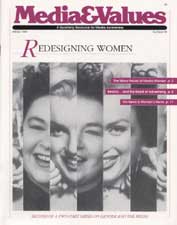No News Is Women's News
|
This article originally appeared in Issue# 49
|
Women's emerging role in society is not reflected in the nation's news media.
In bold, large letters, the August 7, 1989 issue of Time magazine asked: "Is She Worth It?" The she was Diane Sawyer, prime-time newscaster, who had just landed a plum of a job with ABC. Can you remember any instance where the headlines read: "Is He Worth It?" In a field overwhelmingly dominated by men, many of whom are making enormous salaries, it took the rise of this one woman for a corporate media giant like Time magazine to question high media salaries. Why?
Consider, too, how Time described Sawyer. First, she "has it all" because of her "blond-haired good looks." Second, Time lists her charming personality. Last on the list, Sawyer's journalistic skills are noted. How often are men defined primarily by their looks and personalities, and lastly by their capabilities? The continued low economic and social status of women in this country prompts, among other activities, an examination of media coverage of and by women. Focus on the media produces a widely accessible and understandable indicator of women's societal status and their value.
In March 1989, I directed a study of women's roles as newsmakers and creators, one of several related studies released at the second annual Women, Men and Media Conference held in Washington, D.C. in April, 1989. During our monitoring period, the front pages and the first pages of the local section of 10 major, general interest newspapers were examined daily. Counts of bylines by gender, photographs of men and women, and references to men and women were noted.
The newspapers included: The Atlanta Constitution, Chicago Tribune, Houston Chronicle, Los Angeles Times, Miami Herald, New York Times, St. Louis Post Dispatch, Seattle Times, USA Today, and the Washington Post. Consideration in the selection of papers was given primarily to geographic location. Also, an effort was made to include papers from states considered to be bellwether areas for social change. The pages examined were also chosen to see if there was any difference in news coverage of and by women at the international/national level (usually found on front pages) and the local level.
The findings were discouraging.
- Bylines. Female bylines on the front pages averaged 27 percent for the month. They were a little higher on the local front pages, registering 33 percent on average.
- Photographs. Females were represented in only 24 percent of the front page pictures and appeared in only 28 percent of local page photos. Unlike men, females appeared primarily in group shots and were most often seen with their spouses and children.
- References. The average percentage of references to women was abysmally low: 11 percent. They appeared only slightly more frequently (20 percent) on local pages.
Only women in the upper five percent, those who belong to the cultured elite or to the moneyed politician class, can make it into the news. Failing that, women either have to be victims (mainly sex crimes) or criminals to merit mention and to land in the headlines.
– From Images of Women in Philippine Media, 1988
An unexpected finding was the paucity of female sources in stories written by women writers. Female reporters don't appear to seek out female sources any more often than do male writers. Even stories on topics of specific and great concern to women, such as abortion, often contained more quotes from men, and few or no quotes from women.



